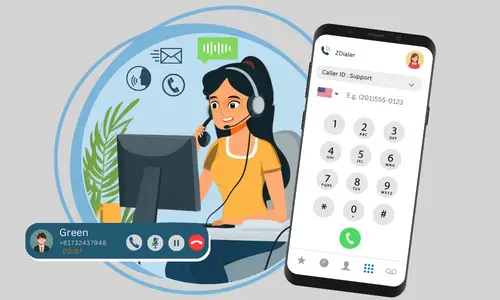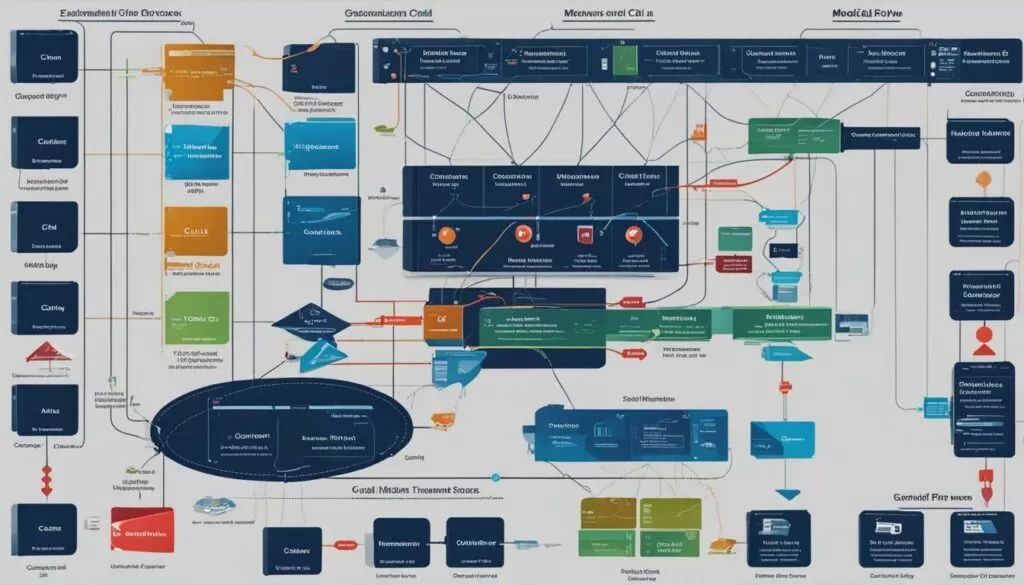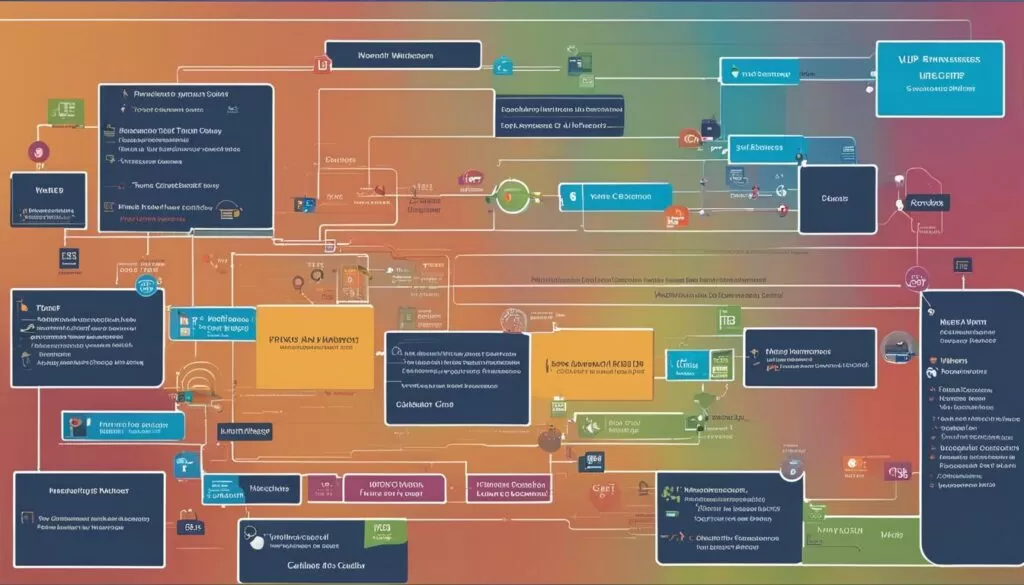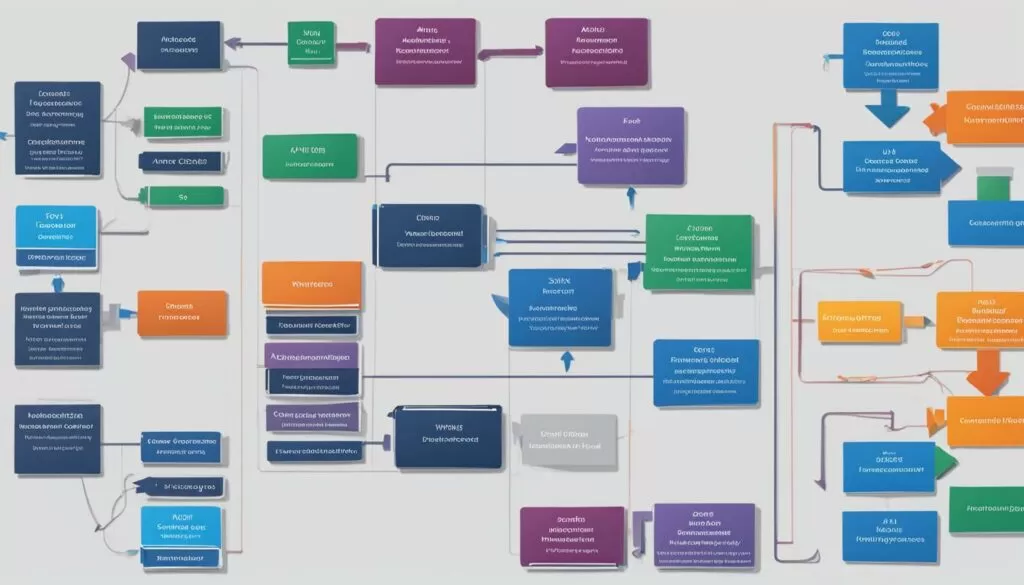As technology continues to evolve, more and more companies are turning to Voice over IP (VoIP) systems for their communication needs. However, with this technology comes the need for understanding the VoIP call flow diagram. It’s an essential tool for optimizing the performance of your VOIP system, but it can often be difficult to comprehend. That’s where My Country Mobile comes in.
At My Country Mobile, we’re dedicated to simplifying the VoIP call flow diagram for you. In this article, we’ll provide a simple and easy guide to understanding this critical tech tool. From the components of the diagram to the mapping of the call sequence, we’ll cover everything you need to know.
Key Takeaways
- A VoIP call flow diagram is essential for optimizing the performance of your VoIP system.
- My Country Mobile can help simplify the understanding of the VoIP call flow diagram.
- The diagram includes components such as call routing and the VoIP call process.
- Visualizing the VoIP call flow can help identify potential issues.
- Best practices for creating an effective diagram include accuracy, clarity, and comprehensiveness.
What is a VoIP Call Flow Diagram?
At My Country Mobile, we understand that VoIP call flow diagrams can be confusing. In simple terms, a VoIP call flow diagram is a visual representation of the various stages involved in a Voice over Internet Protocol (VoIP) call. It helps to illustrate how data and voice packets travel through the VoIP network from the caller to the recipient.
Understanding the VoIP call flow and diagram is crucial to optimizing the performance of a VoIP system. The call flow diagram helps to identify potential issues and provide solutions to enhance the quality of communication.
VoIP call flow diagrams consist of key components, including signaling, media, RTP, SIP, and SDP. Each of these elements plays a unique role in the VoIP call flow and must be accurately represented in the diagram.
At My Country Mobile, we make it our priority to simplify the complex nature of VoIP call flow diagrams and ensure you have a clear understanding of how they work.
Creating a VoIP call flow diagram involves several components that make up the flow of a call. A well-designed diagram should accurately capture all of the stages of a call, from initiation to termination.
The main components of a VoIP call flow diagram include:
- Call Initiator: The person or device initiating the call.
- Signaling: The exchange of data between devices to establish and manage the call.
- Media: The actual audio or video data transmitted during the call.
- Codecs: The technology used to compress and decompress audio and video data for transmission.
- Gateways: The devices that connect traditional phone networks to VoIP networks.
- Session Border Controllers (SBCs): The devices that manage signaling and media between different networks.
- Endpoints: The devices used to initiate or receive the call, such as a phone, computer, or tablet.
When creating a VoIP call flow diagram, it’s important to include all of these components and accurately depict their interactions.
At My Country Mobile, we have extensive experience creating effective VoIP call flow diagrams that capture all of the necessary components. Our team can provide guidance and support to ensure your diagram accurately reflects the flow of your VoIP system.
Visualizing the VoIP call flow is critical to identifying potential issues and optimizing the performance of a VoIP system. By designing a well-structured VoIP call flow diagram, you can diagnose any concerns efficiently and improve the call quality.
One of the primary benefits of visualizing the VoIP call flow is that it helps you to understand how the call travels through the system. VoIP call flow diagrams use symbols and lines to illustrate the path of the call and the processes at each stage. It allows you to identify any inefficient routing or delays in the network.
Another advantage of visualizing the VoIP call flow is that it fosters communication between different teams. When the technical support team and the network team can look at the same diagram, it makes it easier for them to work together to resolve any issues. It also makes it simpler to train new staff members on how the VoIP system works.
At My Country Mobile, we understand the importance of visualizing the VoIP call flow. Our experts can help you create a clear and concise VoIP call flow diagram that meets your specific needs. We use industry-standard symbols and conventions to ensure that the diagram is easily understood.
Understanding the VoIP Call Process
At My Country Mobile, we believe that understanding the VoIP call process is vital to comprehending the VoIP call flow diagram. The VoIP call process diagram breaks down the stages of a VoIP call, from initiation to termination, providing a comprehensive view of the call flow.
The first stage of the VoIP call process is call initiation. This occurs when the caller picks up the phone and dials the number. The call request is then transmitted to the VoIP gateway.
The second stage is call setup. During this stage, the gateway sets up a connection with the recipient’s phone, and a session is established between the two devices.
The third stage is media transfer. This is the stage where the actual audio data is exchanged between the devices. The audio data is transmitted through the network in the form of digital packets.
The fourth stage is called termination. When either the caller or the recipient hangs up the phone, the VoIP gateway terminates the call session.
The VoIP call process diagram helps visualize the flow of the VoIP call by mapping out each stage of the process. By understanding the call process, you can better interpret the VoIP call flow diagram and identify potential issues in the call flow.
At My Country Mobile, we are committed to demystifying VoIP technology for our customers. By breaking down the VoIP call process and providing a clear understanding of the VoIP call flow diagram, we can help you optimize the performance of your VoIP system.
Mapping the VoIP Call Sequence
Understanding the sequence of events that occur during a VoIP call is essential for creating an accurate call flow diagram. The call sequence represents the various stages of a call, from the initiation to termination. At My Country Mobile, we believe that mapping the call sequence accurately is crucial for optimizing the performance of a VoIP system.
The call sequence in a VoIP call flow diagram typically includes the following stages:
- Call setup: This stage involves the initial setup of the call, including dialing the number, number translation, and routing.
- Call progress: At this stage, the system determines if the call is ringing, busy, or unanswered.
- Call handling: During this stage, the call is connected, and the two parties can communicate.
- Call tear-down: Finally, the call is terminated, and the system is reset to handle the next call.
In a VoIP call sequence diagram, each stage is represented by a specific symbol or icon, making it easy to visualize and interpret the flow of the call. For instance, the call setup stage is typically represented by a phone handset and a number, while the call handling stage is represented by two handsets in communication.
Mapping the call sequence accurately in the call flow diagram helps identify potential issues and optimize the system’s performance. It also makes it easier to troubleshoot any problems that may occur during the call.
VoIP Call Routing in the Diagram
Call routing is a vital component of a VoIP call flow diagram. It visualizes the path that a call takes through the network and how routing decisions are made. In a VoIP call flow diagram, call routing is represented as a series of arrows that indicate the direction of the call.
At My Country Mobile, we understand the importance of accurate call routing in optimizing the performance of a VoIP system. Our team of experts can help you create a clear and comprehensive call flow diagram that accurately represents the routing of calls within your network.
When creating a call flow diagram, it is important to consider various aspects of call routing, including:
- How calls are routed between different network elements, such as gateways, PBXs, and IP phones
- The criteria used to determine the best path for a call, such as cost, call quality, and network availability
- The protocols used to transfer calls between different network elements, such as Session Initiation Protocol (SIP) or H.323
By accurately representing call routing in a VoIP call flow diagram, you can identify potential issues and optimize the performance of your system. At My Country Mobile, our team of experts can help you create a call flow diagram that effectively captures the routing of calls within your network.
VoIP call flow diagrams can represent a variety of scenarios, including call transfers, conference calls, and more. Each scenario will have its own unique flow, which must be accurately represented in the diagram.
For example, in a call transfer scenario, the call is initiated with the original caller but then transferred to a new recipient. The diagram must show the path the call takes and the routing decisions made during the transfer.
Conference calls involve multiple parties on the same call. The diagram must show how the call is initiated, including the call routing and how the participants are added to the call.
It is crucial to accurately represent these scenarios in the VoIP call flow diagram to ensure optimal performance of the system. At My Country Mobile, we understand the importance of accurately distinguishing between different VoIP call scenarios, and we can help you create an effective diagram that meets your specific needs.
Creating an accurate and comprehensive VoIP call flow diagram is crucial for optimizing the performance of your VoIP system. At My Country Mobile, we have developed essential best practices to help you create effective call flow diagrams.
1. Define Your Diagram’s Purpose
Before you create your call flow diagram, determine its purpose. What information do you want to convey? Identifying the diagram’s purpose will help you determine which components to include and how to organize them.
2. Include All Relevant Components
Your call flow diagram should include all components of a VoIP call, such as initiation, signaling, media transmission, call routing, and termination. Make sure to include any additional components specific to your system.
3. Use Clear and Concise Labels
Use descriptive and concise labels for each component in your diagram. This will make it easier for others to understand and interpret your diagram accurately.
4. Update Your Diagram Regularly
Your VoIP system will evolve over time, so make sure to update your call flow diagram accordingly. Regularly revisiting your diagram will help ensure its accuracy and effectiveness.
5. Get Feedback
Once you create your call flow diagram, share it with other team members or users to get feedback. This will help identify any potential issues or areas for improvement.
By following these best practices, you can create a clear and comprehensive VoIP call flow diagram that can help optimize the performance of your VoIP system.
Despite the benefits that VoIP call flow diagrams offer, users may face some common challenges in interpreting them. Below are some of the common issues:
- Technical complexity: VoIP technology can be complex, and the diagrams can quickly become difficult to understand for those without a technical background.
- Diagram ambiguity: Sometimes, call flow diagrams can be ambiguous, making it difficult to determine the actual call flow.
- Diagram inconsistency: Diagrams from different sources may not be consistent in format and labels, making it challenging to compare them.
- Lack of context: Inadequate documentation or lack of context can make it challenging to interpret the call flow diagram.
However, at My Country Mobile, we understand these challenges, and we offer solutions to overcome them. We strive to simplify the diagrams so that they are easy to understand and provide comprehensive documentation to help users interpret them.
Our team of experts can help you understand VoIP call flow diagrams, making it easier to optimize your VoIP system. Contact us today to learn more!
Conclusion
At My Country Mobile, we understand the importance of VoIP call flow diagrams in optimizing the performance of VoIP systems. By providing a simple and easy guide to understanding these diagrams, we hope to empower users to confidently navigate and interpret them.
Remember, a well-designed diagram can help identify potential issues and improve the overall performance of a VoIP system. Ensure that your diagram includes all the necessary components, accurately visualizes the call flow, and identifies the call routing path through the network.
Creating an effective call flow diagram can be challenging, but our best practices can help simplify the process. Remember to prioritize accuracy, clarity, and comprehensiveness to ensure that your diagram is useful and easy to understand.
We understand that users may face common challenges when trying to interpret VoIP call flow diagrams. However, by following our solutions and strategies, you can overcome these challenges and make the most of this essential tech tool.
In conclusion, understanding and interpreting VoIP call flow diagrams is crucial in achieving seamless and optimized VoIP communication. With the help of My Country Mobile, you can confidently navigate this essential tech tool and ensure the smooth functioning of your VoIP system.
Frequently Asked Questions
What is a VOIP call flow diagram?
A VOIP call flow diagram is a visual representation of the flow of a Voice over IP (VOIP) call. It illustrates the various stages and components involved in a VOIP call, allowing for a better understanding of the call process.
What are the components of a VOIP call flow diagram?
The components of a VOIP call flow diagram typically include the initiating device, the call processing server, the media gateway, and the destination device. These elements work together to facilitate the routing and transmission of the call.
Why is it important to visualize the VOIP call flow?
Visualizing the VOIP call flow through a diagram helps identify any potential issues or bottlenecks in the call routing process. It allows for easier troubleshooting and optimization of the VOIP system’s performance.
What is the process of a VOIP call?
The process of a VOIP call involves several stages, including call initiation, signaling, media negotiation, media transmission, and call termination. Each stage corresponds to a specific step in the VOIP call flow diagram.
How do you map the VOIP call sequence in a diagram?
Mapping the VOIP call sequence involves accurately depicting the order of events that occur during a VOIP call. This includes signaling messages, media negotiation, and the transmission of audio or video data between the calling parties.
What role does call routing play in a VOIP call flow diagram?
Call routing is an essential aspect of a VOIP call flow diagram, as it visualizes the path that a call takes through the network. It includes decisions on how to route the call based on factors such as availability, cost, and quality of service.
How do different scenarios in a VOIP call flow diagram differ?
Different scenarios in a VOIP call flow diagram can include call transfers, conference calls, or other complex call-handling situations. These scenarios have specific call flow patterns that need to be accurately represented in the diagram.
What are the best practices for creating a VOIP call flow diagram?
When creating a VOIP call flow diagram, it is essential to ensure accuracy, clarity, and comprehensiveness. Use standardized symbols and labeling conventions, and include all relevant components and stages of the call process.































